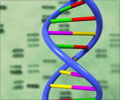American researchers have shown the mechanism whereby broken sections of chromosomes can recombine to change genomes and spawn new species.
The mechanism whereby broken sections of chromosomes can recombine to change genomes and spawn new species, according to US researchers.
"People have discovered high levels of repeated sequences in the genomes of most higher species and spun theories about why there are so many repeats. We have been able to show with yeast that these repeated sequences allow the formation of new types of chromosomes (chromosome aberrations), and represent one important way of diversifying the genome," said Dr. Lucas Argueso, a research scholar in Duke's Department of Molecular Genetics and Microbiology.During the study, the researchers used X-rays to break yeast chromosomes, and then studied how the damage was repaired.
They observed that most of the chromosome aberrations resulted from interactions between repeated DNA sequences located on different chromosomes, instead of a simple re-joining of the broken ends on the same chromosome.
Chromosome aberrations are a change in the normal chromosome complement because of deletion, duplication, or rearrangement of genetic material. On rare occasions, the development of one of these new chromosome structures is beneficial, but more often DNA changes can be detrimental, leading to problems like tumours.
"Every so often the rearrangements may be advantageous. Those particular differences may prove to be more successful in natural selection and eventually you may get a new species," Argueso said.
In the yeast used for this study, the repeated DNA sequences account for about three percent of the genome, and in higher species like humans, about half of the genome consists of these repeated sequences, "which makes for an Achilles heel among humans," Argueso said.
Advertisement
Dr. Thomas D. Petes, chair of Duke molecular genetics and microbiology and co-author of the yeast study, said that sequencing the genomes of different humans had turned up a surprising amount of structural variation between individuals.
Advertisement
These human studies also showed that many of the rearrangements found in humans were at sites of repeated DNA, which might occur through a mechanism similar to what this study found in yeast.
Petes said that the study on yeast could prove relevant to cancer research.
"Most solid tumours have a high level of these rearrangements, as well as a high level of extra chromosomes; recombination between repeated genes is clearly one way of generating rearrangements, although some rearrangements also occur by other pathways. It is an evolutionary battle between normal cells and tumour cells. One way that tumour cells can break free of normal cell growth regulation is to rearrange their genomes," he said.
Source-ANI
RAS/L












